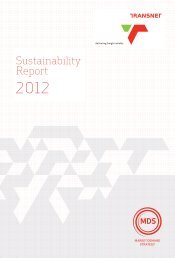Basic Assessment Report - Transnet
Basic Assessment Report - Transnet
Basic Assessment Report - Transnet
You also want an ePaper? Increase the reach of your titles
YUMPU automatically turns print PDFs into web optimized ePapers that Google loves.
<strong>Transnet</strong> LimitedProposed RO Plant: Port of SaldanhaFinal <strong>Basic</strong> <strong>Assessment</strong> <strong>Report</strong>This option greatly increases the number of conveyors required and multiplies thenumber of transfer points. This increase will be a bigger problem than a conventionalstockpile with respect to dust control in that the iron ore has to be elevated and thendischarged into the bins from a height. The arrangement is mechanically complex andvery energy intensive in that the iron ore has to be elevated before being deposited inthe bins.The alternative of taking the bins below ground level has been disregarded because ofthe high water table in the stockyard area. The water table is on average at sea levelwhile the existing stockyard level is ~ 2m above sea level.The option is impractical in terms of construction and has major operationalimplications during construction as well as during operational phases. Due to thesetechnical considerations this option has been discarded in favour of the conventionalstockyard layout currently in use at the iron ore terminal.• Using chemical surfactantsInvestigations into the use of chemical surfactants to suppress dust at the Iron OreHandling Facility have been carried out. A scientifically based wetting philosophyhas been developed for the use of the chemical surfactant in dust suppressionmeasures.Dust suppression chemicals are diluted with water and their use does not eliminatethe need for water. They do, however, make the use of water more efficient.7.4.2 Alternative Sources of Water for Dust SuppressionThe West Coast District Municipality (WCDM) currently supplies the Port ofSaldanha with a maximum monthly volume of 34 000m³ of water. This is conditionalon water saving restrictions which could reduce supply by up to 20% in periods ofdrought.A number of alternative water sources for additional dust suppression at the Iron OreHandling Facility were considered prior to starting the <strong>Basic</strong> <strong>Assessment</strong> process.Various studies have been undertaken by <strong>Transnet</strong> to assess water requirements andusage at the Facility, which included the identification and an assessment of thefeasibility of various water sources currently available.The following potential water sources were considered as options for dustsuppression:• Municipal Potable WaterAdditional potable water from the municipality is limited due to the scarcity of waterin the area and, like the present allocation, is susceptible to restrictions during time ofdrought. Taking into account the sustainability and reliance on the use of municipal33Prepared by the PDNA/SRK Joint Venture
















